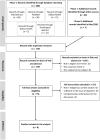Occurrence and Risk Factors of Dog Bites in Northern Indigenous Communities: A Scoping Review
- PMID: 35518635
- PMCID: PMC9064469
- DOI: 10.3389/fvets.2022.777640
Occurrence and Risk Factors of Dog Bites in Northern Indigenous Communities: A Scoping Review
Erratum in
-
Erratum: Occurrence and Risk Factors of Dog Bites in Northern Indigenous Communities: A Scoping Review.Front Vet Sci. 2022 Jul 18;9:971946. doi: 10.3389/fvets.2022.971946. eCollection 2022. Front Vet Sci. 2022. PMID: 35928112 Free PMC article.
Abstract
The relationship between northern Indigenous people and dogs has evolved over the past years alongside events such as colonization, settlement, proliferation of snowmobiling and other socio-cultural and environmental changes. These changes have had negative impacts on this relationship, and with the endemic presence of arctic fox rabies, dog bites have become an important public health burden. The objective of this study was to synthesize the state of knowledge regarding the occurrence of dog bites and associated risk factors in the specific context of northern Indigenous communities. A scoping review was conducted in seven bibliographic databases, from June 2018 to May 2020. From this search, 257 original studies were identified and eight papers were included for final analysis. Annual occurrence of dog bites in northern Indigenous communities ranged from 0.61 to 59.6/10,000 inhabitants. Dog bites affected 27-62.9% of the population in those regions during their lifetime. Very few studies compared the occurrence of dog bites between people living in northern communities with other populations or settings, but available evidence suggests that Indigenous people living in northern communities are at higher risk of dog bites than the rest of the population. Several individual and environmental risk factors were identified in the selected studies, although the strength of evidence varied significantly. Age (children) and gender (male) were well documented individual risk factors. Other factors, such as organizational barriers to dog management and lack of access to veterinary services, were identified and discussed by several authors. The results of this study support concerns about the higher risk of bites in northern Indigenous communities, and underscore the urgent need for more research into the contextual and environmental factors that impact the mitigation of these risks.
Keywords: Indigenous; dog bites; epidemiology; northern communities; scoping review.
Copyright © 2022 Daigle, Delesalle, Ravel, Ford and Aenishaenslin.
Conflict of interest statement
BF was employed by Makivik Corporation. The remaining authors declare that the research was conducted in the absence of any commercial or financial relationships that could be construed as a potential conflict of interest.
Figures


References
-
- Jungsberg L, Turunen E, Heleniak T, Wang S, Ramage J, Roto J. Atlas of Population, Society Economy in the Arctic. Nordregio (2019). Available online at: http://urn.kb.se/resolve?urn=urn:nbn:se:norden:org:diva-5711 (accessed: July 22, 2020).
-
- Einarsson N, Nymand Larsen J, Nilsson A, Young OR. Arctic Human Development Report. Stefansson Arctic Institute, under the auspices of the Icelandic Chairmanship of the Arctic Council 2002-2004. (2004). Available online at: https://oaarchive.arctic-council.org/handle/11374/51 (accessed: Mar 3, 2021).
-
- Wang S,. Indigenous Population in the Arctic. Nordregio (2019). Available online at: https://nordregio.org/maps/indigenous-population-in-the-arctic/ (accessed: July 22, 2020).
-
- Dallmann WK,. Indigenous Peoples of the Arctic Countries. Norwegian Polar Institute (2015). Available online at: https://arctic-council.org/site/assets/files/4330/indig_peoples.png (accessed: July 22, 2020).
-
- Losey R P, Wishart R, Loovers JP. Dogs in the North: Stories of Cooperation and Co-Domestication. Abingdon; New York, NY: Routledge; (2018). p. 298.
Publication types
LinkOut - more resources
Full Text Sources
Miscellaneous

